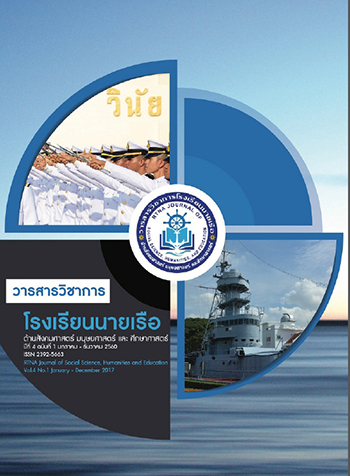Buddhist Criminology: Buddhist Paradigm to Explain Crimes
Keywords:
Buddhist criminology, crime, Buddhist paradigmAbstract
The purpose of this article is to present Buddhist paradigm to explain crime, its cause, and phenomenon based on criminology concepts both in individual and structural dimensions. Even though a writing “Essay on Crime and Punishment” by an Italian criminologist Cesare Beccaria in 1764 who was later honored and become so well known as philosopher of criminology, the Tipitaka, Buddhist scriptures, were fully written with the body of knowledge of criminological concepts long before the mentioned essay. It told us about criminological concepts prior to the western criminologists studied criminology. The Buddhist tipitaka is the valuable wisdom which should be studied for criminological explanation and should to be adapted for policy implementation to use for crime prevention.
References
กรมการศาสนา. (2530). พระไตรปิฎกภาษาไทย ฉบับสังคายนา พ.ศ.2530 เล่ม 1- 45. กรุงเทพมหานคร: โรงพิมพ์การศาสนา.
จุฑารัตน์ เอื้ออำนวย. (2551). สังคมวิทยา อาชญากรรม. กรุงเทพมหานคร: สำนักพิมพ์แห่งจุฬาลงกรณ์มหาวิทยาลัย.
ปกรณ์ มณีปกรณ์. (2555). ทฤษฎีอาชญาวิทยา. กรุงเทพมหานคร: ห้างหุ้นส่วนจำกัด เวิร์ลเทรด.
ประธาน วัฒนวาณิชย์. (2546). ความรู้เบื้องต้นเกี่ยวกับอาชญาวิทยา, กรุงเทพมหานคร: สำนักพิมพ์ ประกายพรึก.
ปุระชัย เปี่ยมสมบูรณ์. (2525). การควบคุมอาชญากรรมจากสภาพแวดล้อม:หลักทฤษฎีและมาตรการ. กรุงเทพมหานคร: คณะรัฐประศาสนศาสตร์ สถาบันบัณฑิตพัฒนบริหารศาสตร์.
_______ . (2538). อาชญาวิทยา: สหวิทยาการว่าด้ายปัญหาอาชญากรรม. โครงการตำรา โรงเรียนนายร้อยตำรวจ, กรุงเทพมหานคร: โรงพิมพ์จุฬาลงกรณ์มหาวิทยาลัย.
พรรษพร ยกเชื้อ. (2541). “พุทธศาสนากับปัญหาอาชญากรรมในสังคมไทย: ศึกษาความคำนึงถึงศีล 5 ของผู้กระทำความผิดในเรือนจำกลางคลองเปรม.” วิทยานิพนธ์มหาบัณฑิต สาขาวิชา ศาสนาเปรียบเทียบ คณะศิลปศาสตร์ มหาวิทยาลัยมหิดล.
พรชัย ขันตี และคณะ. (2543). ทฤษฎีและงานวิจัยทางอาชญาวิทยา. ศูนย์หนังสือมหาวิทยาลัยมหิดล, กรุงเทพมหานคร: สำนักพิมพ์บุคเน็ท จำกัด.
พระธรรมปิฎก (ป.อ. ปยุตโต ). (2539). พจนานุกรมพุทธศาสตร์. กรุงเทพมหานคร: สำนักพิมพ์มูลนิธิพุทธธรรม.
_______ . (ป.อ. ปยุตฺโต). (2550). พุทธธรรม. ฉบับปรับปรุงและขยายความ มหาจุฬาลงกรณราชวิทยาลัย, กรุงเทพมหานคร: บริษัท สุทธิด่านการพิมพ์ จำกัด.
วศิน อินทสระ. (2533). พระสุตตันตปิฎกอังคุตตรนิกาย. กรุงเทพมหานคร: สภาการศึกษามหามกุฎราชวิทยาลัย.
เสริน ปุณณะหิตานนท์. (2558). การกระทำผิดในสังคม สังคมวิทยาอาชญากรรมและพฤติกรรมเบี่ยงเบน. กรุงเทพมหานคร: สำนักพิมพ์แห่งจุฬาลงกรณ์มหาวิทยาลัย,พิมพ์ครั้งที่ 3.
โสภา ชปีลมันน์. (2537). อาชญากรรม : ปัญหาที่ควรแก้ไขในสังคมปัจจุบัน. พิมพ์ครั้งแรก. กรุงเทพมหานคร: สำนักพิมพ์ไทยวัฒนาพาณิช.
อัณณพ ชูบำรุง. (2532). อาชญาวิทยาและอาชญากรรม. กรุงเทพมหานคร: คณะสังคมศาสตร์ มหาวิทยาลัยเกษตรศาสตร์.
______ . (2531). รายงานการวิจัย เรื่อง สาเหตุแห่งการเกิดอาชญากรรมตามหลักพระพุทธศาสนา. กรุงเทพมหานคร: สถาบันวิจัยและพัฒนาแห่งมหาวิทยาลัยเกษตรศาสตร์.
Palmer, Stuart. (1973). The prevention Of Crime. New York: Behavioral Publications, Department of Sociology University of New Hampshire.
Voigt, Lidia.; (1994). Thronton, William E.; Barrrile, Leo. Jr.; and Seaman, Jerrol M. Criminology and Justice. New York: McGraw – Hill.
Vold, George B.; (1998). Bernard, Thomas J.; and Snipes, Jeffery B. Theoretical Criminology. Oxford: Fourth Edition, Oxford University Press.
Published
Issue
Section
License
Copyright (c) 2017 Royal Thai Naval Academy

This work is licensed under a Creative Commons Attribution-NonCommercial-NoDerivatives 4.0 International License.
The author has the sole responsibility for the material published in RTNA Journal of Social Sciences, Humanities, and Education, which the editorial team may not agree on that material.
RTNA Journal of Social Sciences, Humanities, and Education owns the copyright of the text, the illustration, or other material published in the journal. No parts or the whole of the material published may be disseminated or used in any form without first obtaining written permission from the academy.






